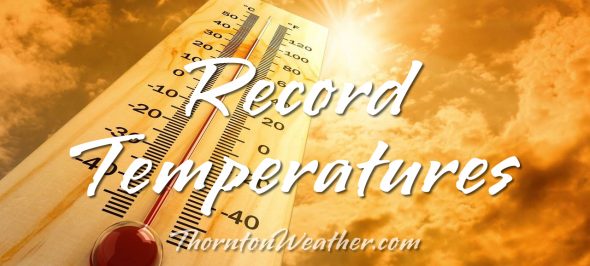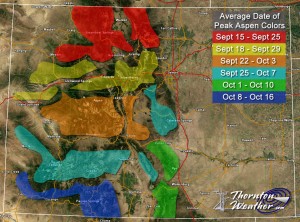The first full week of September sees us start one of the most pleasant times of year in Denver. While less common this time year, severe weather can and does occur. Our look back at this week in Denver weather history includes hail, damaging wind and even smoke from wildfires hundreds of miles away.
From the National Weather Service
1-5
In 1995…record breaking heat occurred on the first 5 days of the month when the temperature climbed into the 90’s on each day. Record high temperatures of 97 degrees on both the 1st and 4th equaled the all-time record maximum for the month. High temperature of 95 degrees on the 3rd was a record for the date. High temperatures of 94 degrees on both the 2nd and the 5th were not records. The low temperature of 64 degrees on the 4th equaled the record high minimum for the date.
1-7
In 1978…the temperature reached 90 degrees or more on seven consecutive days with the highest temperature…94 degrees… Recorded on both the 4th and 6th.
1-30
In 2020…a worsening drought that started in the spring and continued through September. Outside of an early season snow on the 8th…the month of September was another unseasonably warm and dry period. The combination of hot…mostly dry conditions…and critically dry fuels… resulted in a continuation and rapid expansion of several massive wildfires. The Cameron Peak fire…which became the largest in the state`s history started on August 13th…and continued through September. As a result…very poor air quality continued to impact Denver and the entire Front Range. Denver recorded the most days ever with a high temperature of 90 degrees or better; 75 days. The last of which was 91 degrees on the 24th. The previous record was 73 days set in 2012.
2-3
In 1892…there was a trace of rainfall each day. This… Together with a trace of rain on both the 7th and 8th…was the only rainfall of the month…making the month the driest on record. The monthly record was equaled in 1944.
3
In 1901…a thunderstorm produced rain…hail of unknown size… And south winds sustained to 40 mph with gusts to 43 mph.
In 1961…Labor Day snow storm is the earliest date of the first snow…trace and measurable…of the season. The heavy wet snow broke many limbs from trees that were still in full foliage. The storm produced 4.2 inches of snowfall at Stapleton Airport with nearly a foot of snow in western suburbs and in the foothills. Minimum temperature of 33 degrees was a record for the date and the coldest ever recorded so early in the season.
In 1999…severe thunderstorms dumped large hail across metro Denver. Hail as large as 1 inch in diameter was measured near Cherry Creek in Aurora and near Bennett. Hail to 3/4 inch in diameter fell in the city of Denver.
In 2002…a thunderstorm produced a wind gust to 51 mph at Denver International Airport.
In 2003…very heavy thunderstorm rain washed out parts of the Virginia Canyon Road above Idaho Springs. Up to 4 feet of mud reportedly washed down the road during the storm. Several vehicles were trapped on the road.
In Idaho Springs…several streets…including the main street… Were also buried in mud and gravel. Some buildings in town experienced minor flooding…including the basement of the town library and the police station.
3-6
In 1909…rainfall for the 4 days accumulated to 3.97 inches in Boulder…while in Denver rainfall totaled 2.45 inches on the 4th…5th…and 6th.
4
In 1909…apparent post-frontal heavy rainfall totaled 1.94 inches in downtown Denver. North winds were sustained to 19 mph.
In 1944…a trace of rain fell. This together with a trace of rain on the 9th…10th…and 30th was the only precipitation for the month. The total of a trace of precipitation for the month equaled the driest September on record first set in 1892.
In 1960…the highest recorded temperature in September…97 degrees…occurred. The same temperature also occurred on September 5…1899…September 1…1995…and September 4… 1995.
In 1989…a strong thunderstorm wind gust flipped a plane taxiing on a private runway in Adams County east of Denver. Two people were slightly injured and the plane was heavily damaged.
In 1992…strong winds developed across metro Denver behind a pacific cold front. Sustained winds above 40 mph with gusts as high as 60 mph were recorded mainly in and near the foothills. Pre-frontal south winds gusted to 37 mph at Stapleton International Airport.
In 1995…two people were injured when lightning struck their home in Lakewood. The lightning entered the attic where it started a small fire. It then traveled through the walls… Exploding a mirror and spraying glass on the residents. Lightning also sparked small grass fires near Aurora…Denver International Airport…and Bennett. The highest recorded temperature in September…97 degrees…occurred. The same temperature also occurred on September 5…1899…September 4…1960…and September 1…1995.
In 2000…thunderstorm winds gusted to 64 mph in Castle Rock.
5
In 1899…the highest recorded temperature in September…97 degrees…occurred. The same temperature was also reached on September 4…1960…and September 1 and 4…1995.
In 1940…a severe wind and hail storm confined mostly to the west and north parts of the city occurred shortly after 4:30 pm. Hail stones ranged in size from 1/4 to 1/2 inch in diameter. In north Denver…hail piled to a depth of 4 inches. Flooding occurred in one underpass…which stalled 2 cars. One girl was injured when the weight of the hail flattened a porch on which she stood. Northeast winds were sustained to 29 mph with gusts to 32 mph in downtown Denver.
In 1987…a thunderstorm complex produced hail as large as 1 3/8 inches in diameter…2 miles east of Buckley Field in Aurora. No damage was reported.
5-8
In 2020…a strong upper level low brought an end to record heat to the Front Range urban corridor…and provided Denver its second earliest measurable snowfall on record. Numerous heat records were set leading up to the snowfall…and several new snowfall and cold records were also broken in this abrupt bout with winter. Denver set its all time record high for September…reaching 101 degrees during the afternoon. This was also the latest date a 100 degree reading has ever been observed in Denver. Another daily record high was then tied on September 6th when Denver hit 97 degrees. September 7th was the last day of heat when Denver`s high temperature reached 93 degrees. That tied Denver for the record for the number of 90 degree days for a year at 73…and was also the warmest temperature ever recorded before a day of measurable snowfall. By the evening of September 7th…a series of cold fronts progressed southward from Wyoming into Colorado… dropping the temperature into the low 30s by the early morning hours of September 8th. Snow developed across the Front Range mountains and foothills overnight… while a mix of rain and snow developed along the I-25 corridor. A few locations picked up light snowfall accumulations in the morning. Accumulating snow was mostly confined to the higher elevations much of the day…before spreading across the plains during the late afternoon and evening. Storm totals ranged from 4 to 10 inches in the mountains…with 3 to 6 inches near the foothills. A total of 5.6 inches of snow was measured at the NWS Boulder office…while at Denver International Airport…the official measurement was 1.0 inch. Continue reading September 3 to September 9: This week in Denver weather history





